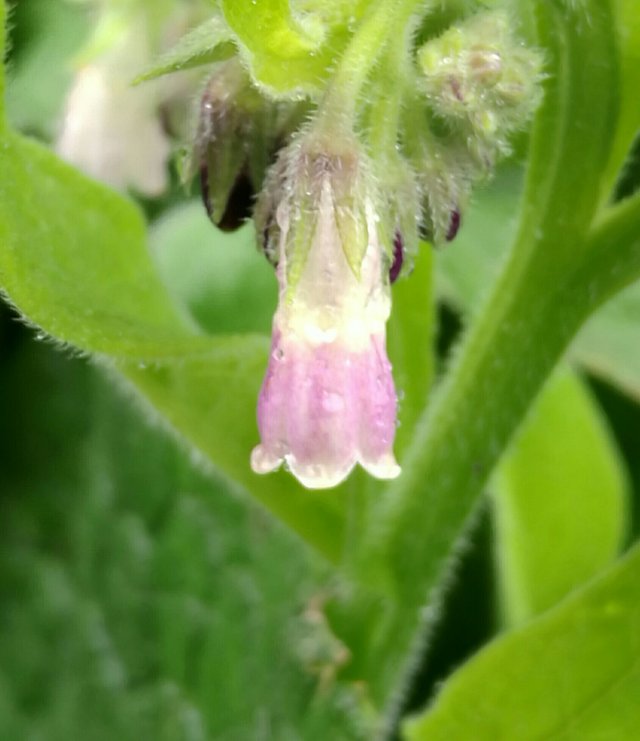Comfery (Symphytum officinalis)

Common names: Comfrey, Kintbone, Boneset
Taxonomic name: Symphytum officinalis
Family: Boraginaceae
Uses: Healing wounds, broken bones, a great benefit to the garden
Area of origin: Eurasia
Warnings: Contains pyrrolizidine alkaloids, so can cause liver problems in susceptible people when taken internally. Not to be used in pregnancy.
There are a few varieties of Comfrey. We’ll just use the generic name ‘Comfrey’ for the most commonly used varieties – Common or ‘True’ Comfrey (Symphytum officinale) and Russian Comfrey (Symphytum x uplandicum). For our humble purposes they can be treated the as the same. Comfrey is a close relative of another, popular garden herb, Borage.
Comfrey is an amazing plant from the view of both gardeners and herbalists. Its deep roots bring up valuable nutrients from way down in the soil and make them accessible through the leaves. It is this that causes gardeners to cherish it. The leaves can be added to composts to give them a kick. I just throw them around the garden to break down as they will.
It accumulates Nitrogen, Phosphorus and Potassium (the holy trinity of gardening) as well as Calcium. The term for this sort of plant is ‘dynamic accumulator’.
Enough gardening you say! Ok, on to the herbalism…
Comfrey is a mucilaginous herb that is slightly astringent and contains a chemical called ‘allantoin’ that stimulates cell growth. You may know from other pages that I’m not big on lists of chemicals in herbs, but when a herb has something as powerful as this, it pays to pay attention to it.
It is allantoin that gives Comfrey its fame as a wound healer (it’s one of a class of herbs called ‘vulneraries’ or ‘wound healers’). Allantoin causes cells to grow like crazy. – hat is also why we need to be careful with it, as we will see later. We also see allantoin in that other great healer, Plantain.
The energetics of Comfrey are as important as the allantoin for they guide us to the best manner to use it. Comfrey is cooling and moistening, also it is astringent.
How does that guide us to its use?
As we know, Comfrey is great for external wounds. So many wounds get red and inflamed – just the right thing for something that is cooling and moistening. Wounds can bleed or weep, just what an astringent can be used for.
So, we see Comfrey as being able to help with inflammation and possible bleeding as well as being able to cause the body’s cells to proliferate and heal the physical damage of the wound. It’s a great all rounder for external wounds.
An interesting use for Comfrey is to cause calluses to grow. Who would do such a thing? Weightlifters, tradesmen, gymnasts…the list of folks who need callused hands or feet is quite long, but you get the picture. Applying fresh Comfrey leaves or ointment to hands that need to be tougher will cause the skin to thicken and harden.
Comfrey heals wounds from the outside in, unlike say, Calendula, which heals from the inside out.

Comfrey is, probably, most famous for its ability to heal broken bones. That’s how it gets one of its common names – ‘knitbone’. I’ll be honest, I can’t comment on this from personal experience, I’ve never been called on to heal someone with a broken bone. But, Comfrey is so famous for this that I’d be remiss if I didn’t mention it.
Applying Comfrey poultices to the area over a fracture will cause the bones to heal quickly. However, caution must be taken and it is vital that the bones have been set first.
If we look back to the garden for a little, we may remember that Comfrey accumulates, amongst other things, Calcium and Phosphorus. That’s exactly what bones are made of!
Comfrey is so good at its job of healing wounds that it can cause too much or too rapid healing. Breaks that are healed by Comfrey can, apparently, grow a callus on the bone. Deep cuts that are healed with Comfrey can heal over at the surface, trapping contaminants and infection below (I’ve seen this).
Now, you’ve probably heard that Comfrey, like its cousin Borage, contains pyrrolizidine alkaloids. These have been linked to liver damage in susceptible people and should be warned against. If you or your patient has a history of liver problems, is undergoing a detox programme, or is a heavy drinker, then think twice about Comfrey.

Comfrey’s big, wide leaves also point to its external use. They are just like big, green bandages themselves. The best way to use it is to crush up a few leaves and place them on the wound, then get a whole leaf and place that over the top before securing with either pressure or a bandage.
You've been visited by @minismallholding from Homesteaders Co-op.
I’ve featured your post in the Homesteaders – Living Naturally newsletter.
A community marketplace of ethical, handmade and sustainable products available for STEEM, SBD (and USD): https://homesteaderscoop.com
follow: @homesteaderscoop
Thank you @minismallholding!
Those comfrey leaves look bug and lush. Mine aren't looking too great. Hope I've not got curl grubs going at them from underneath.
@tipu curate
Upvoted 👌 (Mana: 5/15 - need recharge?)
ours were small last year. Lots more water this year is the trick